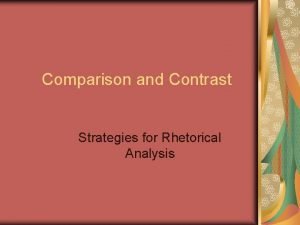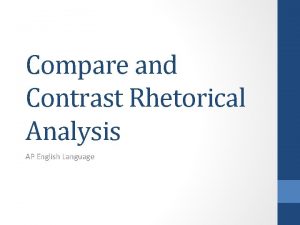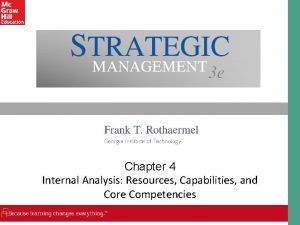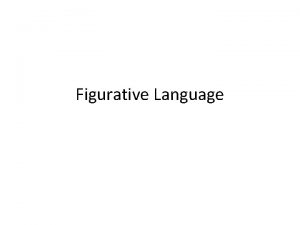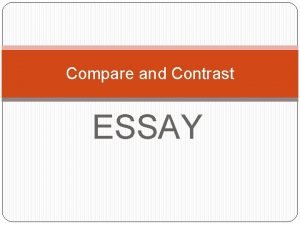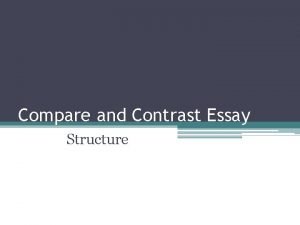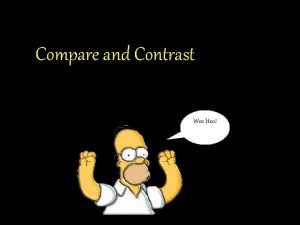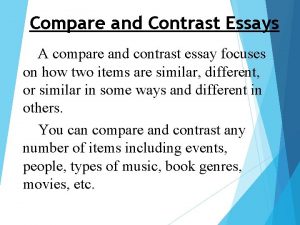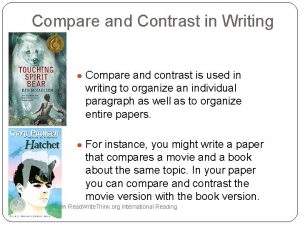Compare and Contrast Rhetorical Analysis AP English Language








- Slides: 8

Compare and Contrast Rhetorical Analysis AP English Language

Developing your Point by Point Comparison • A comparison makes a point by discussing the similarities between two or more topics. A contrast makes a point by discussing the differences between two or more topics. To support a point through comparison or contrast, a writer identifies the comparable points of the topic, offers relevant and concrete descriptions and examples for each comparable point, and effectively uses coordination and subordination of ideas.

Making Your Point • When you write a comparison or a contrast piece, you limit your thoughts to a set of topics based on their relationship to each other. Most likely you have an opinion or belief about the two topics and their comparable points. Your opinion is your point or main idea. In a comparison or contrast paragraph, you also reveal your opinion by discussing the topics and their points of similarities or differences in the order of your own choosing. A topic sentence states the overall point of the comparison or the contrast between the two topics. For example, the following topic sentence contains (1) the comparable topics, (2) the writer’s opinion about the topic, and (3) the pattern of organization used to organize details.

The Thesis Statement • Even though the (tone) (genre) _______ by _____ and (tone) (genre) _______ by _____ both …, they differ in …

The Evidence: Present Ideas in a Logical Order • Once you have identified the comparable points between your topics and have focused on a main idea, you are ready to generate and organize additional details. To make a point using comparison or contrast, a writer moves from a general idea (the comparison or contrast of two or more topics) to a major support (a comparable point about the topics) to minor supports (details or examples of the comparable point about the topics). To signal the movement among these levels of ideas, a writer uses transitions to signal similarities or differences and examples. Strong transitions establish coherence, a clear and understandable flow of ideas.

Words That Signal Comparison • alike, equally, in the same way, likewise, • As, in a similar fashion, just as, resemble, • Similarly, as well as, in a similar way, just like

Words That Signal Contrast • Although, conversely, differently, on the other hand • as opposed to, despite, even though, most, still • at the same time, difference, in contrast, nevertheless, on the contrary • But, different, in spite of, unlike

Example Details • Both ___ and ___ express the purpose of … • Although ___’s tone is ___, ___’s tone is ___; they differ because …
 Compare and contrast rhetorical analysis
Compare and contrast rhetorical analysis Compare and contrast rhetorical analysis essay example
Compare and contrast rhetorical analysis essay example Compare and contrast first and second language acquisition
Compare and contrast first and second language acquisition Compare and contrast swot, vca, rbv, and 3-circle analysis.
Compare and contrast swot, vca, rbv, and 3-circle analysis. Juxtaposition figurative language
Juxtaposition figurative language Romeo and juliet vs west side story
Romeo and juliet vs west side story Compare and contrast maynard jackson and andrew young
Compare and contrast maynard jackson and andrew young Draw and label a longitudinal wave
Draw and label a longitudinal wave Compare and contrast spring tides and neap tides.
Compare and contrast spring tides and neap tides.
